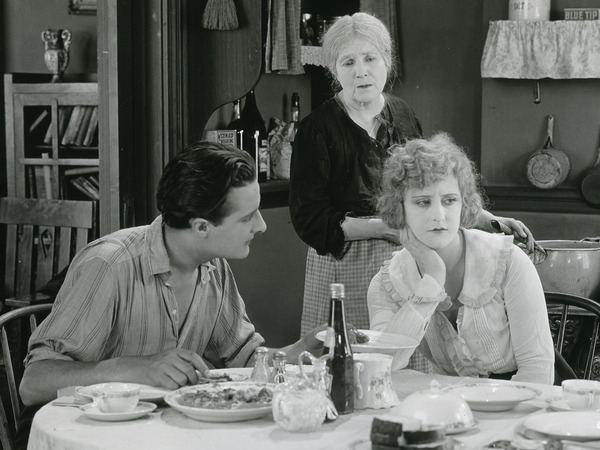THE SONG OF LIFE
John M. Stahl (US 1922)
Advertised as “a Drama of Dishes and Discontent,” The Song of Life stands out in Stahl’s oeuvre for its focus on poverty and the gritty realism of its settings. The director was quoted as saying the film had “a theme which he has been saving for several years with the intention of using it when he had his own production unit” (which he did under Louis B. Mayer Productions, for which this was his fourth release), suggesting it may have had special importance to him, or that he felt it needed careful handling. The story was credited to Stahl’s wife Frances Irene Reels, with a screenplay by Bess Meredyth, a well-respected screenwriter (of films such as the 1926 Don Juan and the Garbo vehicle A Woman of Affairs), who would later marry director Michael Curtiz and, according to the director’s associates, contribute behind the scenes to many Curtiz films.
Women’s frustration with marriage – and its alternatives – was a common theme in Stahl’s silent films, most often playing out in fashionable drawing rooms in comedy-dramas like Why Men Leave Home and Husbands and Lovers. Rarely did Stahl consider the domestic drudgery of wives too poor to keep servants. The Song of Life opens with a startling, vivid prologue that prefigures Victor Sjöström’s The Wind (1928) with its depiction of a woman isolated in a desert shack (filmed in the Mojave Desert) scoured by wind and sand, oppressed by a brutish “clod” of a husband and chained to a bottomless tub of dirty dishes. Her desperate flight from this wretched life is the seed of a mother-love plot that takes a number of credibility-straining melodramatic twists, reuniting this woman with the grown son she abandoned as a baby, and with the son’s wife, whose dissatisfaction mirrors her own. The script hedges its sharp observations on women’s problems – for instance, the vanity of men’s desire to be the sole breadwinners and the degree to which they take for granted women’s unpaid and unglamorous domestic labor – with more conventional sentiments. Since the character of the son is a struggling author engaged in writing an autobiographical “slice of life” novel, the film manages to comment on its own genre and on the tension between honesty and melodrama.
None of the film’s stars is well-remembered today, and none had significant careers in sound films. Georgia Woodthorpe, who plays the elderly mother, was in her sixties by the time she entered films, after a distinguished stage career; her grandson would become far more famous – director George Stevens. Grace Darmond, who retired from the screen in 1927, is less known now for her acting than for being the lover of Jean Acker – who allegedly fled to Darmond’s home on the night of her wedding to Rudolph Valentino. Her look of sharp, discontented intelligence is well-suited to her role here. French-born Gaston Glass was a moderately successful romantic lead, starring in Frank Borzage’s Humoresque (1920). He was amusingly described by the Portland Telegraph as “enough of the artist type to please the ladies and at the same time not enough of one to turn the men against him.”
Much of the film is set in New York’s Lower East Side, which is presented with almost neorealist pungency. Street scenes show tenements festooned with laundry, crowds milling around pushcarts and colorful vendors, and children playing in gutters and stairwells. Cinematographer Ernest Palmer, making his second film with Stahl, would go on to photograph Borzage’s Seventh Heaven and Street Angel and Murnau’s City Girl; here his work is both concise and atmospheric, making palpable the sweaty, noisy, claustrophobic environment that the young wife played by Darmond yearns to escape. There is comedy about tenement life – a rowdy family across the airshaft, a mischievous organ grinder’s monkey that sneaks in windows to raid kitchens – and some nice touches of underplayed humor in the music store where the young wife works and fends off flirtatious customers.
Reviewers of the time were impressed by the film’s level of realism, with a number falling back on such clichés as “true to life,” or “a slice of real life.” Appraisals were mixed, however, with many critics finding the plot hackneyed and unconvincing, just one more “sob story,” even while admiring the directorial skill applied to it. The Los Angeles Times reviewer’s assessment, though condescending, is broadly applicable: “the plot is such a crude one, and has been so admirably refined in the process of transforming it to the silver sheet. Mr. Stahl has, I believe, a faculty for taking the trite and commonplace and making them seem like something.” In some of Stahl’s best-known films (e.g., Magnificent Obsession), he takes the crudest of melodramatic plots and makes them do more than just seem like something; against all odds, he makes them ring true.
Imogen Sara Smith

regia/dir: John M. Stahl.
scen: Bess Meredyth.
sogg/story: Frances Irene Reels.
photog: Ernest G. Palmer.
asst dir: Sidney Algier.
cast: Gaston Glass (David Tilden), Grace Darmond (Aline Tilden), Georgia Woodthorpe (Mary Tilden), Richard Headrick (figlio del vicino/neighbor’s boy), Arthur Stuart Hull (procuratore/District Attorney), Wedgwood Nowell (Richard Henderson), Edward Peil (Amos Tilden), Fred Kelsey (ispettore di polizia/Police Inspector), Claude Payton (agente/Central Office man), [Miriam Bellah].
prod: John M. Stahl, Louis B. Mayer, Louis B. Mayer Productions.
dist: Associated First National Pictures.
uscita/rel: 02.01.1922.
copia/copy: 35mm, 6910 ft. (orig. 6920 ft.), 83′ (22 fps); did./titles: ENG.
fonte/source: Library of Congress Packard Center for Audio-Visual Conservation, Culpeper, VA.


 Italiano
Italiano